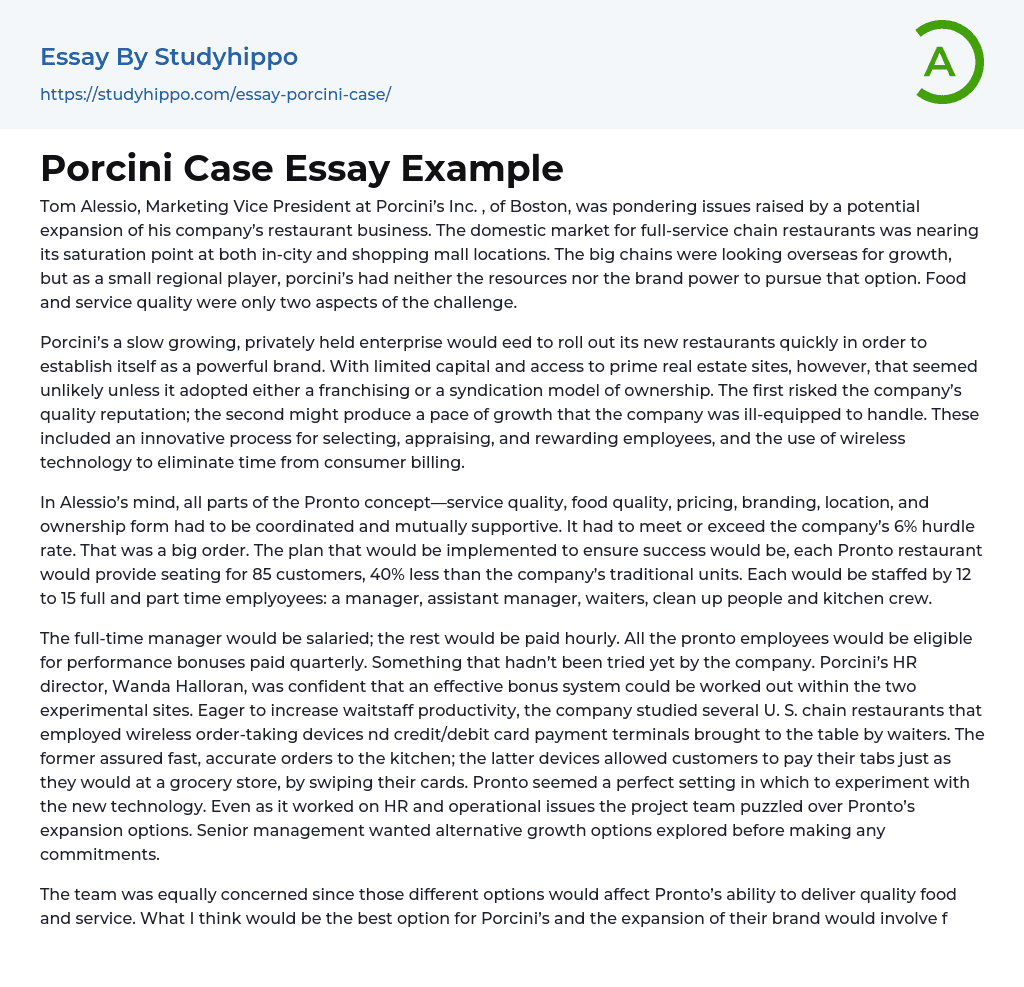Tom Alessio, Marketing Vice President at Porcini’s Inc. , of Boston, was pondering issues raised by a potential expansion of his company’s restaurant business. The domestic market for full-service chain restaurants was nearing its saturation point at both in-city and shopping mall locations. The big chains were looking overseas for growth, but as a small regional player, porcini’s had neither the resources nor the brand power to pursue that option. Food and service quality were only two aspects of the challenge.
Porcini’s a slow growing, privately held enterprise would eed to roll out its new restaurants quickly in order to establish itself as a powerful brand. With limited capital and access to prime real estate sites, however, that seemed unlikely unless it adopted either a franchising or a syndication model of ownership. The first risked the
...company’s quality reputation; the second might produce a pace of growth that the company was ill-equipped to handle. These included an innovative process for selecting, appraising, and rewarding employees, and the use of wireless technology to eliminate time from consumer billing.
In Alessio’s mind, all parts of the Pronto concept—service quality, food quality, pricing, branding, location, and ownership form had to be coordinated and mutually supportive. It had to meet or exceed the company’s 6% hurdle rate. That was a big order. The plan that would be implemented to ensure success would be, each Pronto restaurant would provide seating for 85 customers, 40% less than the company’s traditional units. Each would be staffed by 12 to 15 full and part time emplyoyees: a manager, assistant manager, waiters, clean up people and kitchen crew.
The
full-time manager would be salaried; the rest would be paid hourly. All the pronto employees would be eligible for performance bonuses paid quarterly. Something that hadn’t been tried yet by the company. Porcini’s HR director, Wanda Halloran, was confident that an effective bonus system could be worked out within the two experimental sites. Eager to increase waitstaff productivity, the company studied several U. S. chain restaurants that employed wireless order-taking devices nd credit/debit card payment terminals brought to the table by waiters. The former assured fast, accurate orders to the kitchen; the latter devices allowed customers to pay their tabs just as they would at a grocery store, by swiping their cards. Pronto seemed a perfect setting in which to experiment with the new technology. Even as it worked on HR and operational issues the project team puzzled over Pronto’s expansion options. Senior management wanted alternative growth options explored before making any commitments.
The team was equally concerned since those different options would affect Pronto’s ability to deliver quality food and service. What I think would be the best option for Porcini’s and the expansion of their brand would involve franchising and having franchisee’s. My reasoning is because it has the least risk financially involved with starting up a pronto restaurant. As long as the contract is made up and there are checks and balance’s to ensure the franchise is being run under the same rules, regulations, ethics, and standard that any other Porcini brand company would provide.
- Brand Equity essays
- Branding essays
- Nike, Inc. essays
- Market share essays
- Razor essays
- Advertising essays
- Audience Theory essays
- Competitor Analysis essays
- Consumer essays
- Marketing Management essays
- Marketing Mix essays
- Marketing Plan essays
- Marketing Research essays
- Marketing Strategy essays
- Point Of Sale essays
- Price essays
- Procurement essays
- Product essays
- Product Differentiation essays
- Promotion essays
- Promotion And Marketing Communications essays
- Retailing essays
- Trademark essays
- Anheuser-busch essays
- Brands essays
- Detergent essays
- Product Placement essays
- Research Design essays
- New Product Development essays
- Advertisement essays
- Brand essays
- Sales Promotion essays
- Advertising campaign essays
- Consumer behaviour essays
- Offer And Acceptance essays
- Wal-Mart essays
- Discover essays
- Optical Fiber essays
- Freezing essays
- Polymer essays
- Fast Food Restaurant essays
- Board Of Directors essays
- Brand Management essays
- Business Ethics essays
- Business Management essays
- Change Management essays
- Comparative Analysis essays
- Decision Making essays
- Dispute Resolution essays
- Knowledge Management essays




